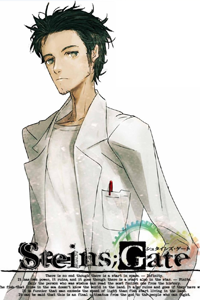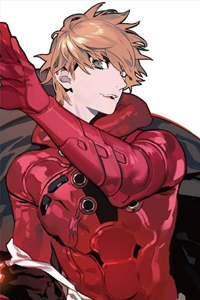Part 119: Supplementary Lesson #4: The Chuunibyou Archetype

Previous Analysis: Doctors
I know that I said I would try to avoid using Japanese words in order to be more accessible towards the less anime-inclined readers, but I think this is going to be the one big exception to the rule, since Anghel’s character archetype isn’t easily defined.
Do you remember those kids in middle school who pretended they had superpowers, or that they were secretly a Saiyan and could shoot Kamehamehas out of their hands? And they’d always talk about how special they were and how they got their powers? And then when the other kids would ask them to show off his powers, he’d make some excuse like “Something has been draining my power” or “I can’t really control it, so I don’t know”? But they would still stand by their assertion that they were a hero? That’s chuunibyou.
Chuunibyou (lit. “eighth grade syndrome”) is a fairly new archetypal term, at least in terms of its popularity. The first use of the term is credited to Japanese radio host Hikaru Ijuin, where on a 1999 broadcast he referred to himself as “contracting” chuunibyou, and would read stories on-air of others who were dealing with chuunibyou, which he referred to as “the things people normally do during their second year of middle school”. It was meant to define staying young at heart, and the kinds of silly aspirations that children have. From there, use of the term began to spread, until it eventually became a meme for Japanese internet users, and became derogative slang for delusional people in general, rather than the more specific case of child-like silliness that it originally stood for.
It’s generally seen as a sort of defense mechanism, pretending to be like someone you’re not in order to look cooler or be more popular. This is referred to in psychology as “identification”, and in cases of chuunibyou is largely focused on anime, manga, or video game characters.
There are three general types of chuunibyou:
DQN (Gangster-like)
These kinds of people act like delinquents: anti-social and hostile. They spin tales of gang fights and crimes, they make up facts about thug life, and are often very proud of their totally real gangster subculture.
Subcultural/Hipster (Portland-like)
The name makes it self-explanatory, but these are the people who avoid anything “mainstream” so that they can seem cultured and special. With children, you’ll often see kids who are into Western music or who are really into drinking coffee. This entry specifically refers to people who are not actually interested in the hipster subculture, but rather those who appropriate the subculture to make themselves look cool and unique.
Evil Eye (Goku-like)
These are the people who pretend to have magical powers, often creating an alias or alternate identity for their superpowered self. This is the most standard usage of the term, and is referred to as the “delusional” type of chuunibyou. This is the subset where Anghel falls.
The chuunibyou archetype, while becoming more popular recently, is not particularly common in anime or other associated works. In fact, there are no otome games that contain chuunibyou characters, possibly due to inherent immaturity, which can be a turn-off and an undesirable trait.
However, I think it would be good to share some more general examples of the trope in media.

Rintarou Okabe is the main character of the visual novel-turned-anime Steins;Gate. He is a self-proclaimed mad scientist and villain, and will often partake in strange mannerisms such as talking to himself via cell phone and laughing maniacally in order to keep up this persona. He always wears a lab coat, and asks to be referred to as “Kyouma Hououin” when he’s acting as a mad scientist. However, he does not truly believe himself to be a mad scientist, but rather he acts like this in order to entertain his childhood friend Mayuri Shiina. Rintarou is still a bit eccentric and awkward in his own right, but he understands that his mad scientist act is indeed just that. In this way, he has self-inflicted chuunibyou.

Masayoshi Hazama is one of the main characters of Samurai Flamenco, an anime by Manglobe. A male model by occupation, Masayoshi has a love for Super Sentai/Power Rangers-type shows, and has always desired to be a hero of justice. One day, he decides to get a custom sentai suit made to finally live out his dreams as a hero. While he has no fighting experience, he gives his all when acting as a superhero, trying to instill the concepts of truth and justice into the delinquents he runs into while on patrol. He believes himself able to convince these kids of the path of justice, and able to hold his own in battle, although neither of these are particularly true. Still, he never gives up on his dreams and believes that with enough dedication he can truly become a hero like the ones on TV.

Chuunibyou Demo Koi ga Shitai!, or Love, Chuunibyou & Other Delusions, is a light novel series-turned-anime by Kyoto Animation. It follows a boy, Yuta Togashi, who in middle school had chuunibyou and called himself the Dark Flame Master, which ended up alienating him from his fellow classmates. He ends up finding this behavior embarrassing, and tries to reinvent himself in high school. However, a girl with chuunibyou, Rikka Takanashi, catches wind of Yuta’s past and becomes interested in him and his Dark Flame Master persona. She herself believes that she is a sorceress with the ability to see other people’s destinies through her “Wicked Eye”, which she keeps hidden behind a medical eyepatch. Hilarity ensues as the two begin to become friends and they start to learn more about each other’s lives.
While the anime in general is very light, it does explore some themes on how people who have chuunibyou come to “contract” it and how it plays a part in different people’s lives. While it’s a romantic comedy at heart, there’s some neat character development in it.
While the concept of chuunibyou may have been named and classified in 1999, it probably wasn’t until the release of the anime adaptation of Chuunibyou Demo Koi ga Shitai! In 2012 that I think it really hit the public consciousness, particularly in the West where the term itself doesn’t have a particularly good translation, and as such would be their first introduction to the term. It’s a concept that appears to be very recognizable and relatable, but relatively uncommon, and so chuunibyou characters might begin to pop up more in Japanese media, particularly with how popular Chuunibyou Demo Koi ga Shitai! became.
Next Analysis: Playboys